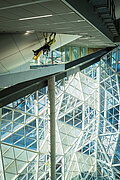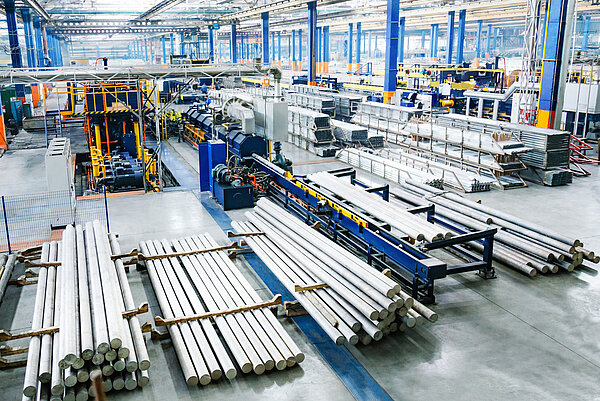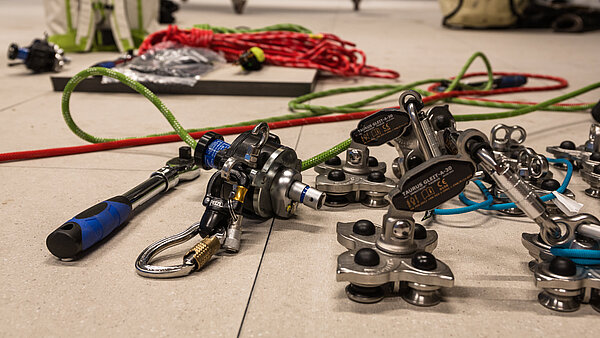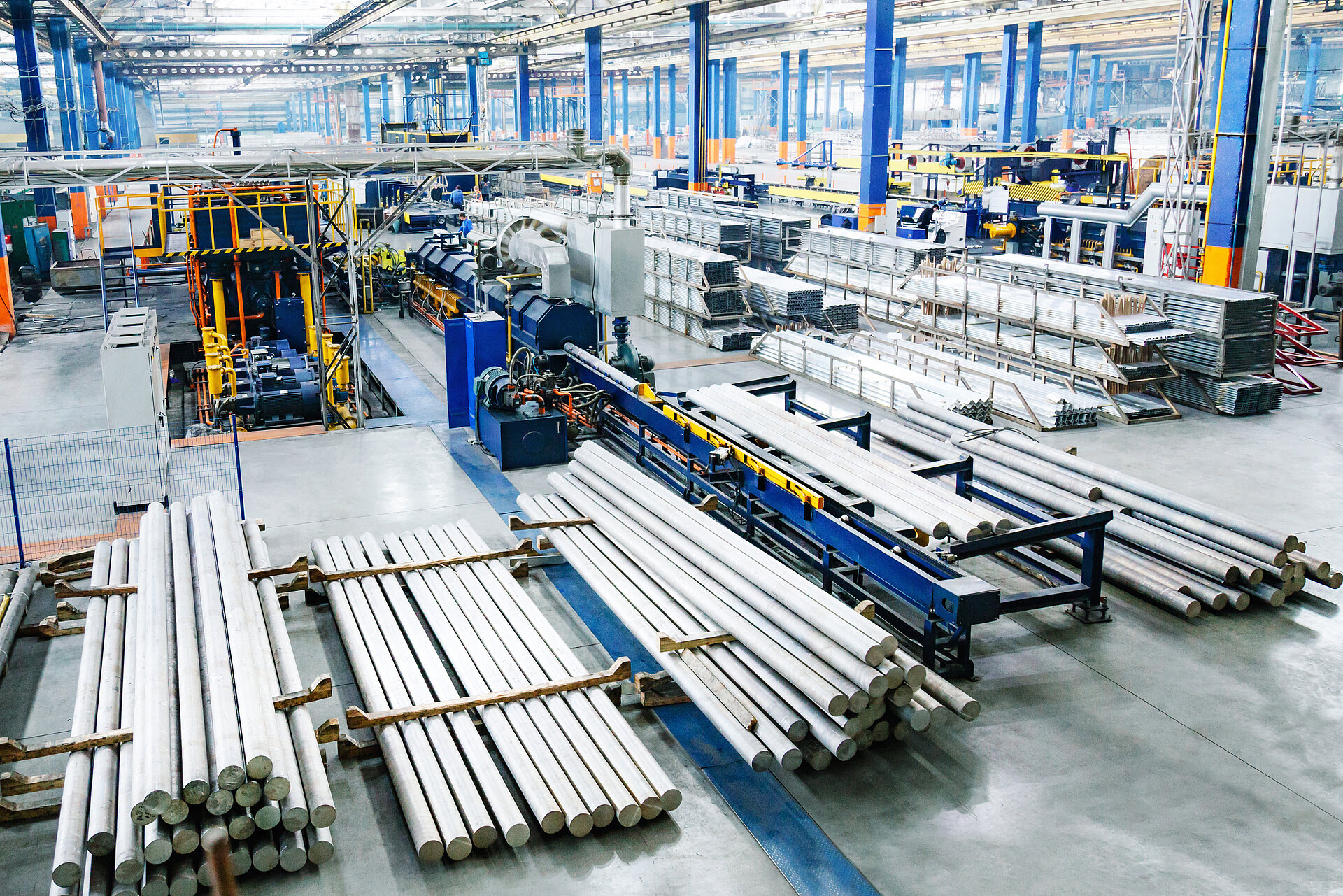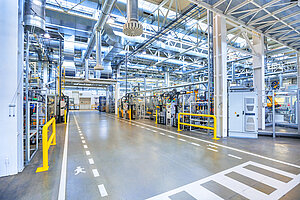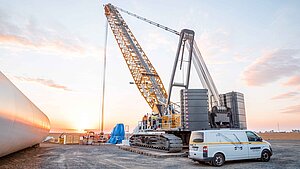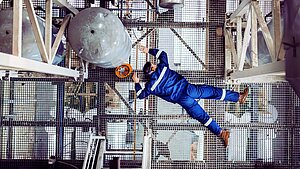Fall protection is more than just a few clamps, bolts, cables, and harnesses. It requires a holistic safety concept which guarantees the industrial safety of employees and employers at all times. In industrial operations where huge machines, plant, and cranes are in use, numerous fall hazards lurk, such as standing areas for servicing and operation of the machines, stairways, ceiling openings, or dangers on traffic routes. According to Suva, the Swiss accident insurance company, of all accident risks, falling while at work is the most fatal, and this can happen from a height of only 3 metres. Almost every second fatal fall accident is also accompanied by a dangerous head injury.
It is therefore even more important that companies with these types of danger zones ensure the best possible industrial protection for all employees in the workplace. The return on prevention is demonstrably positive, because fall protection is always cheaper than a fall. In this post, we have combined together for you what an appropriate and effective fall protection system includes, and the costs involved, plus professional tips.
Planning and service for all-round protection
An appropriate and effective fall protection system is based on a holistic safety concept which, as a rule, is implemented by several specialist experts who collaborate closely and can offer specialist knowledge and many years of expertise. The related services, such as substructure inspection, planning service or the development of special solutions, ensure optimum all-round protection in industrial operations.
What are the costs generated by planning and service for fall protection?
In addition to the once-off cost of planning, annual costs for continuing services must be allowed for, e.g. the annual inspection prescribed by the standards. In this, an internal or external assessor checks that there are no cases of an illusion of safety, for example because the danger areas are secured 24/7.
Professional tips about planning and service for fall protection
Before planning, the local conditions must be assessed very carefully.
When selecting a provider, ensure that all specialists are certified by the respective manufacturer, and that they can demonstrate references and experience of fall protection in industry.
Installation of the appropriate and effective fall protection system
The installation of the fall protection system must be performed appropriately and effectively by trained fitters. There must be no errors at this stage, because even the smallest defects can have disastrous consequences if there is a fall. Top-quality products such as anchorage devices and fasteners from reliable manufacturers are supplied with clear installation instructions in multiple languages, supported by images. In addition, for every product an installation and acceptance log (checklist) should also be available.
What costs arise for installation?
Once the planning of the fall protection system is complete, the installation company will deliver all materials to the customer, and will install the equipment directly onsite as per the manufacturer’s specifications. The simpler it is to install the products, e.g. fasteners, and the fewer the obstacles present at the location to be protected, then the faster the fitter can work, and the more cost-efficient the installation for you as the customer.
Professional tips for installing the fall protection system
If the project is considered holistically, then there is no problem with effective planning by the manufacturer or his partners
The fitter should use the supplied fasteners exclusively, and should comply with the installation instructions, because this is the only way to ensure the safety of the fall protection system.
If there are queries, it is advisable to contact the manufacturer directly, even if this causes a few hours of additional effort and expense.
Check with the installation company whether the fitter being deployed has current installation training certification for fall protection (this is renewed every 3 years).
A trained safety expert (internal or from the installation company) must provide instruction about the fall protection system to your employees. According to Austrian industrial safety law, an inspection (TÜV) and civil engineer or a legally authorised expert in your own company develops the user guide.
Documentation of the installed fall protection system
After the fall protection system has been installed, detailed photo-documentation is necessary, because this forms the basis for the mandatory annual inspection. As per the current legal foundations (EN 795 and EN 365), the obligation to document is legally governed. If personal injury and material damage occur, then the assessors and courts resort to this document.
What costs arise for the documentation?
Above all, the costs of documentation for the fall protection system depend on who is entrusted with this task. On the one hand, this can be the installation company itself, who makes a trained specialist available. In Austria the rate for this is between 50 and 85 euros/h. Or else you decide on an independent inspection (TÜV) and civil engineer/expert, which will result in somewhat higher costs (approx. 500 to 1,200 euros). On the other hand, there is also the option of training an internal employee, and this is the cheapest variant in the long term. The INNO|School training to become a safety expert costs between 400 and 500 euros, and must be renewed every three years.
Professional tips for documenting the fall protection system
Documentation should be created carefully and painstakingly, in order to avoid future problems during servicing.
Documentation software such as INNO|doc significantly simplifies and accelerates both the documentation and the inspection.
Servicing of the fall protection system
At least once per year, the fall protection system must be inspected and serviced, in order that defects and indications of wear are recognised in good time, and corrected where necessary. Reasons for problems include changes related to weathering, chemical effects, overloading, changes in the building structure, material fatigue, or misuse. PPE (personal protective equipment) must also be serviced annually, as specified by the respective manufacturer. The inspection must be documented in the test log or in INNO|doc, and must be kept with the instruction manual.
What costs arise for servicing?
The costs of servicing depend on the size and scope of the fall protection system. This varies not only according to the cable length, types of systems, installed accessories, for example, but also according to the difficulty of the local conditions. If insufficient documentation is available, then servicing cannot be concluded positively, and so consequential costs arise, or the system may even have to be renewed.
Professional tips for servicing the fall protection system
It is important that a qualified expert familiar with the fall protection system performs the servicing.
The number of times per year that the system is serviced depends on the frequency of use, because the more frequently the system is used, the more the materials wear.
Servicing contracts for periods of 3 to 5 years make this task easier for the fitter, because he knows the equipment, and as a rule the customer can make savings.
Summary: A real fall protection system pays for itself
The implementation of a fall protection system in industrial operations is intended to save lives. There should therefore be no cutting corners to save costs; instead it is better from the very start to rely on experienced partners and high-quality products, because these ensure a reliable, long-lasting, and efficient safety system.
Would you like to find out more about sustainable safety concepts in industrial operations? Then download our manual about fall protection in industry now, free of charge.






